Pomp & Circumstance: Graduating from Preschool Storytime
Hi, I’m Nancy and I’m a conference junkie. Not just any conference, only those related to children’s librarianship and literature. My favorites are the Virginia Hamilton Conference on Multicultural Literature for Youth held annually in April at Kent State University (Kent, Ohio); and the Mazza Museum: International Art from Picture Books Weekend Conference held each November at the University of Findlay (Findlay, Ohio). You never know when or how inspiration for storytimes or programming will strike.
At the Mazza Weekend Conference a couple years ago, I had the privilege of hearing some fine authors and illustrators speak about their craft as well as their inspiration. Will Hillenbrand, Eugene Yeltsin, Robin Preiss Glasser, John Marciano, John Rocco and Patricia Polacco all spoke with enthusiastic glee over their work for children. When Patricia Polacco spoke of her family traditions in terms of literary inspiration, I had my lightbulb moment of the conference.
 As she recounted, children at about age 4 were given the gift of a book. Upon the cover of the book was a smidge of honey. She was instructed to wipe up the honey then lick the honey off her finger. Sweet, no? Well, what is inside a book is also sweet–knowledge, entertainment, the gift of words and of imagination. But just as the bees work very hard to make the honey, so do people have to work hard to read what is contained in books.
As she recounted, children at about age 4 were given the gift of a book. Upon the cover of the book was a smidge of honey. She was instructed to wipe up the honey then lick the honey off her finger. Sweet, no? Well, what is inside a book is also sweet–knowledge, entertainment, the gift of words and of imagination. But just as the bees work very hard to make the honey, so do people have to work hard to read what is contained in books.
At the time, I was responsible for preschool storytime–for children 4-5 years old who had not yet entered kindergarten. Many of my crew that year were on the older side, ready to move up into kindergarten the following August. Planning began on storytime graduation party for the final meeting in the Spring.
First, I contacted our very generous Friends group who graciously donated enough picture books for each child to select one. As the last storytime date approached, I started warning caregivers that there would be photo-worthy moments at the last meeting. Well, it seems everyone showed up for that last program. I read books about the joy of reading, we sang Learning Station’s “Read a Book”. With the last activity, I asked the kids to line up in the front of the room where I usually sit (and I had to send plenty of siblings back to the grownups for this!).
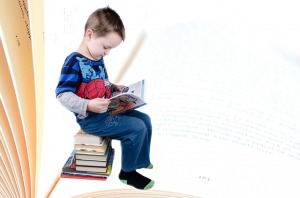 Then a tray of tiny cups with a dab of honey and a toothpick inside were passed around. “What is this?” “EW!” and other comments were muttered not so quietly. I asked them to lick the toothpicks. What did it taste like, salty or sweet? Runny or sticky? They all said sweet, a few said “gross”, and one young lady hollered, “It’s honey!” I let them know it was, indeed honey and it is sweet. Where does honey come from? Unanimous reply, “Bees!” Right! “And the bees work very hard flying from flower to flower collecting pollen then fly back to the hive to deposit the pollen where other bees turn it into honey, their food.” They looked confused. “Well, sometimes we have to work hard to earn a sweet reward too.” My coworker passed out books to the preschoolers. “You have worked hard all year during storytime working on letters and sounds and making words. You are earning the sweet reward of reading books. Each of you has graduated from storytime and you all may keep this book to remember how sweet it is to read.” I also created a bookmark (photo to come) that congratulated them on graduating from storytime.
Then a tray of tiny cups with a dab of honey and a toothpick inside were passed around. “What is this?” “EW!” and other comments were muttered not so quietly. I asked them to lick the toothpicks. What did it taste like, salty or sweet? Runny or sticky? They all said sweet, a few said “gross”, and one young lady hollered, “It’s honey!” I let them know it was, indeed honey and it is sweet. Where does honey come from? Unanimous reply, “Bees!” Right! “And the bees work very hard flying from flower to flower collecting pollen then fly back to the hive to deposit the pollen where other bees turn it into honey, their food.” They looked confused. “Well, sometimes we have to work hard to earn a sweet reward too.” My coworker passed out books to the preschoolers. “You have worked hard all year during storytime working on letters and sounds and making words. You are earning the sweet reward of reading books. Each of you has graduated from storytime and you all may keep this book to remember how sweet it is to read.” I also created a bookmark (photo to come) that congratulated them on graduating from storytime.
I still see pictures come across my Facebook feed a couple of years later as parents remember this most fun graduation ceremony.
Lullaby and Goodnight…Bedtime Storytime
When I did bedtime storytime, I did wear pajama pants and a shirt with our library logo. I wore slippers (well, really a pair of treaded fuzzy socks). Families that attended wore pajamas (well, the kids did and maybe a couple moms). However, I did not read bedtime stories. Ever. Why not? First, there aren’t enough good books about the subject to keep me or the families interested for a 9 week session and forget about enough to do all bedtime books for a whole year. I did find a way to tie a nighttime storytime into the bedtime title: I used a dreamcatcher (inspired by the directions here).
 Some colleagues do a magic trick to introduce the storytime theme. I find that the items or laminated images that go into the magic bag are too small for all the kids in a large storytime to see. So I thought the dreamcatcher could catch clues & we could noodle out the theme together from the clues. The dreamcatcher could be hung from the ceiling, but since I have a short window to setup and tear down for other programming, I decided to just attach the top of the dreamcatcher to a tripod. Then each week I would weave images into the yarn as if the dreamcatcher had trapped those thoughts. For example, during the Autumn theme, there were fall leaves and pictures of pumpkins and apples in the dreamcatcher. Or for farm week, there was a barn, a cow, a pig and a chicken.
Some colleagues do a magic trick to introduce the storytime theme. I find that the items or laminated images that go into the magic bag are too small for all the kids in a large storytime to see. So I thought the dreamcatcher could catch clues & we could noodle out the theme together from the clues. The dreamcatcher could be hung from the ceiling, but since I have a short window to setup and tear down for other programming, I decided to just attach the top of the dreamcatcher to a tripod. Then each week I would weave images into the yarn as if the dreamcatcher had trapped those thoughts. For example, during the Autumn theme, there were fall leaves and pictures of pumpkins and apples in the dreamcatcher. Or for farm week, there was a barn, a cow, a pig and a chicken.
During the first storytime for each session, I would explain what a dreamcatcher is. I’d also say that my giant dreamcatcher mostly catches good things, not the scary things, so that I could remember good stories to tell. Then I’d say I fell asleep before they arrived and I hadn’t had time to check what was caught from my dream. Together we would identify each clue then figure out what they all had in common. Then on with the stories, rhymes, songs and finger plays!
The biggest challenge of bedtime, or family, storytime, is preparing for a diverse crowd. I found that even simple stories could work for older, more sophisticated storytime participants as long as we followed a simple story with an activity. My favorite thing to do each week was come up with an action song that had everyone up in a circle acting out the theme. For example, during the Autumn theme, we sang “Autumn Leaves Are Falling Down” (to the tune of London Bridge Is Falling Down). Each verse had an action tied to autumn leaves: First they were falling down, then we had to rake them up, then we jumped into the pile.
Like any good storytime, I would include at least 2 books, an action song, a puppet or flannel story, and some sort of motor activity to transition to the books. I usually included an open ended craft that was appropriate for a wide range of ages that could be done in about 5 minutes. After the craft, we turned down the lights, I would yawn and say how nice it was to share a dream with them this week. We would sing “Twinkle Twinkle Little Star” softly. As they left the room, I’d pass out a small snack to eat at home before they went to bed. Sleep tight, little ones!
*Note: The dreamcatcher above is not the one I created for storytime. That one has been repurposed and I never took a picture of it before dismantling.
School Aged Storytime Remix
So, the first storytime I did as a librarian was bedtime storytime. Tough work planning for a wide age range that varied week to week. When the chance to create a storytime for school aged kids, I was thrilled! The same age group every time! Well….
My first experience with the kindergarten through second grade set happened the previous Fall when no one–NO ONE–wanted to do storytimes for them. So, all the children’s staff took turns doing one storytime each for the the session. My theme was music and it went, well, meh. Tough crowd. The younger kids loved the structure, but the second graders were so not into a variation on “baby” storytime (as one kid politely told me). Sheesh, even though we made our own instruments, jammed as a band, marched, danced the “Funky Chicken,” and did rhythm challenges, this was somehow a baby storytime. My coworkers had similar experiences.
Why would I be thrilled to take on this group solo the following Spring? Knowing what worked, what was insulting to the older kids, and what time of day we offered the program gave me all the information I needed to take a dead program and bring it to life. Maybe I have a Frankenstein complex.
Since storytime started about an hour after the end of the school day, I started every session with snacks. Since the second graders had told me that they like crafts A LOT, usually the snack was also a craft. After the snack was made, they ate while I read. And the books had to be totally funny, adventurous, or outrageous or I’d lost them (even with the food). Then to throw them off guard, we’d follow the snack & story with some gross motor activity to burn off some of the snack energy.
The second book was always something interactive followed by a craft or activity. Sometimes we did a third book (only if they were game and if I’d found one short but compelling). Then to end, we did a craft or activity. As they cleaned up after the last activity, they each got a bookmark I’d made telling their caregivers what we did, what we read, along with a list of similar books & activities to check out or do at home.
This is what the first one looked like.
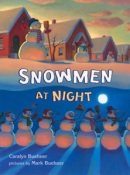 This was January 2013. Snowy, snowy winter here in NE Ohio. So I chose a snow theme. As the kindergarten through second graders came into the room, they were told to find a seat at the table where I had placed three small powdered sugar donuts with one piece of candy corn and a small pile of mini chocolate chips on a paper plate for each child. They also had a bottle of water which I’d relabeled as “Melted Snowman.” (Got the idea for the snowman labels here.) After their snowman snacks were assembled, they sat on the floor with their plates and waters and I read Snowmen at Night (Buehner). I knew this book was a hit when I saw puffs of powdered sugar when the kids snickered.
This was January 2013. Snowy, snowy winter here in NE Ohio. So I chose a snow theme. As the kindergarten through second graders came into the room, they were told to find a seat at the table where I had placed three small powdered sugar donuts with one piece of candy corn and a small pile of mini chocolate chips on a paper plate for each child. They also had a bottle of water which I’d relabeled as “Melted Snowman.” (Got the idea for the snowman labels here.) After their snowman snacks were assembled, they sat on the floor with their plates and waters and I read Snowmen at Night (Buehner). I knew this book was a hit when I saw puffs of powdered sugar when the kids snickered.
While they threw out their paper plates & wiped faces, hands & pants, I put on “The Skaters” (from the CD The Vienna I Love Waltzes from My Heart by Andre Rieu). Each child got 2 paper plates and proceeded to skate around the carpeted room. I worried a bit that things might get out of hand, but I told them to skate in a circle like they were on a lake and they did. Some talented kids skated backwards or did spins. So. Much. Fun!
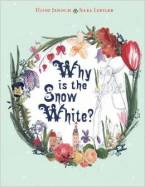 Needless to say, they weren’t anxious to sit down after the song was done…but that was what I’d hoped for. The next book was Why Is the Snow White? (Janisch). I had stacks of scarves in the colors mentioned in the book and divided the crew into teams of colors. We started by having everyone stand up and wave their colors. Isn’t it beautiful? Then they sat down as I read the book. Every time a color was mentioned, that crew came forward and waved their scarves until Father Snow eliminated the color. They left their scarves in a basket and sat back down. In the end, I covered myself in a white sheet then threw it over them. This was a bigger hit than I’d expected–they wanted to read it again.
Needless to say, they weren’t anxious to sit down after the song was done…but that was what I’d hoped for. The next book was Why Is the Snow White? (Janisch). I had stacks of scarves in the colors mentioned in the book and divided the crew into teams of colors. We started by having everyone stand up and wave their colors. Isn’t it beautiful? Then they sat down as I read the book. Every time a color was mentioned, that crew came forward and waved their scarves until Father Snow eliminated the color. They left their scarves in a basket and sat back down. In the end, I covered myself in a white sheet then threw it over them. This was a bigger hit than I’d expected–they wanted to read it again.
Once I told them our next activity, they were eager to move on. I made 2 giant snowmen using 3 circles of white paper and tacked them to the wall. In teams, the kids rolled giant dice to see which part of their snowman they could add (hat, scarf, nose, button x3, eyes x2, arms x2, and mouth x4). The game was inspired by this game.
I skipped the third book because I figured they had cabin fever and would appreciate more games. I was going to read Lois Ehlert’s Snowballs but, hey, they’ve probably heard that one before. So I let them choose which of 2 stations they wanted to play: a snowman bowling game (empty water bottles with a few beans in the bottoms to weigh them down a little with white labels to make them look like snowmen, then they rolled softball-sized wiffle balls at them; or, a snowflake cutting station with templates to cut folded paper then glitter glue to make them sparkle. I offered iPad time, but no one wanted to play that day.
I wouldn’t change a thing about this storytime. Giving the kids choices and offering breaks from stories or songs made a world of difference. The activities were appropriate for a wider range of kids; the books encouraged a little critical thinking but also provided entertainment; and providing a snack met the needs of this group. I still love working with school aged kids but have moved up to the “tween” group, grades 3-5, doing an art program I call Express Yourself.
WW2 backdrop for defining family
Gingersnap by Patricia Reilly Giff; Random House Children’s Books, New York, 2013; 147 pages.
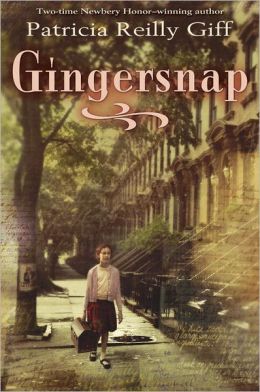
Jayna’s only living relative, that she knows of, is her brother Rob. When Rob ships out for Okinawa during World War II, she is left in the care of their landlady. Before he left, Rob mentioned a box with a mystery diary, what seems to be a collection of recipes written in French. Distraught by the news that Rob is missing in action, Jayna searches for the book. Clues begin to add up: a bakery named “Gingersnap” (Jayna’s nickname) in Brooklyn (where Rob always said they belonged). With bags packed, Jayna searches for any family connection and discovers that family means so much more than blood-ties.
This heart-touching story of a girl in search of family transcends the setting of the book. World War II lessons of hardship, like rationing, are heavily featured, and present teachable moments about that period in our history. But the real story is of hope, patience, and what ties bind us together through all of life’s hardship and happiness.
I loved Giff’s addition of Jayna’s recipes for soup in the book. Her skill in making soup from next to nothing was a key to Jayna’s character. By adding the simple recipes, children can be encouraged to experiment with ingredients themselves–whether those ingredients are art materials, pencil and paper, or veggies from the refrigerator.
So many connections can be made by librarians and teachers. A basic soup cookbook for kids could be paired with it for a “better together” book display. I think this book compared & contrasted with other tales of American children during World War II would be an interesting display or recommended to read together. Imagine Navigating Early (Clare Vanderpool), The Green Glass Sea (Ellen Klages), and maybe My Chocolate Year: A Novel with 12 Recipes (Charlotte Herman) bundled together?
I am not surprised that Gingersnap got a starred review in Kirkus. It’s a wonderful story for readers aged 8-12.
Fascinating spy story for younger readers
Ariel Bradley, Spy for General Washington by Lynda Durrant, illustrated by Joe Rossi; Vanita Books, Akron, OH; 2013.
Note: This review is based on an uncorrected color proof provided for free by the publisher. The book is due on shelves September 1, 2013.
 Ariel Bradley was a spy for General George Washington during the American Revolutionary War. He was also a boy, a child. General Washington asked the boy to act like “Johnny Raw,” or a simple country kid, and spy on the British & Hessian armies. By pretending he was seeking a mill to grind a sack of corn, Bradley was able to determine how many soldiers had amassed against General Washington.
Ariel Bradley was a spy for General George Washington during the American Revolutionary War. He was also a boy, a child. General Washington asked the boy to act like “Johnny Raw,” or a simple country kid, and spy on the British & Hessian armies. By pretending he was seeking a mill to grind a sack of corn, Bradley was able to determine how many soldiers had amassed against General Washington.
This true story is told in simple terms that will make the Revolutionary War a little more real for beginning chapter book readers. It’s easy to read, full of vocabulary that will be useful in history class, and inspirational (what kid wouldn’t want to be the spy and hero?). The illustrations are warm, inviting and help tell the story within the story by highlighting facial expressions and old-fashioned clothing.
Combining a well-told true story with inviting illustrations make this a perfect story for the Fourth of July. Because of the resources in the back of the book (a glossary as well as information about the real Ariel Bradley and his life after the American Revolution), I will be recommending it to teachers as a read-aloud in social study classes in elementary school.
Eep! Quirky allegory
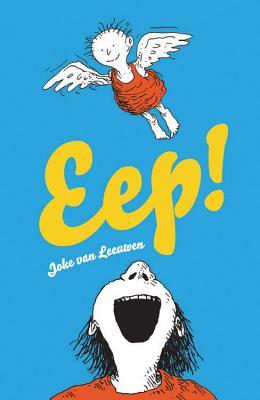 Eep! by Jake van Leeuwen, translated by Bill Nagelkerke; published by Gecko Press USA, an imprint of Gecko Press Ltd., New Zealand; 2012.
Eep! by Jake van Leeuwen, translated by Bill Nagelkerke; published by Gecko Press USA, an imprint of Gecko Press Ltd., New Zealand; 2012.
Warren is a bird watcher. One day, while doing what he loves, he spotted a small bird under a bush. Only it wasn’t a bird: It was a girl with a face and legs and feet but wings where her arms should be. Warren carried the precious gift home to his wife, Tina, who longed for a child. Named Beedy, the girl learned what she could under their care. But Beedy also longed for freedom and left one morning without saying goodbye. On their quest to find Beedy to say goodbye, Warren and Tina, and Beedy, all encounter others longing for various things in their own lives. In the end, they all have the chance to say goodbye to Beedy and she disappears on her own adventure.
Part Roald Dahl, part Shel Silverstein, this quirky little allegory will have different meanings for different readers. I won’t share what I took away from the allegory since every reader has to glean his or her own meaning from the book. This book will appeal to fans of Dahl (especially his shorter quirkier tales). I’d also recommend it as a read aloud in elementary schools, especially for 3rd or 4th grade classes, as it begs for discussion and interpretation; good skills to work on with students in this age group.
Dead End in Norvelt may be acquired taste
Dead End in Norvelt by Jack Gantos; published by Farrar Straus Giroux, New York; 2011.
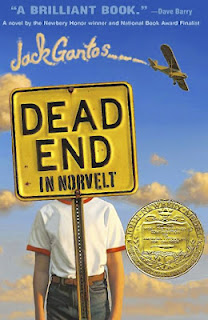 Summer vacation for Jack Gantos (the protagonist kid, not the author) is not going as planned. Caught in the middle of his feuding parents, he has been grounded for life. Chores and reading, that’s it. Digging a bomb shelter for his dad by day and creating an igloo of books that he’s finished reading by night comprise his entertainment. That is, until his mom asks him to help his feisty old neighbor write obituaries for the quickly dying founders of Eleanor Roosevelt’s post-war promised land, Norvelt. Between humorous observations, history lessons, and stress-induced bloody noses, this summer isn’t going to turn out so bad after all.
Summer vacation for Jack Gantos (the protagonist kid, not the author) is not going as planned. Caught in the middle of his feuding parents, he has been grounded for life. Chores and reading, that’s it. Digging a bomb shelter for his dad by day and creating an igloo of books that he’s finished reading by night comprise his entertainment. That is, until his mom asks him to help his feisty old neighbor write obituaries for the quickly dying founders of Eleanor Roosevelt’s post-war promised land, Norvelt. Between humorous observations, history lessons, and stress-induced bloody noses, this summer isn’t going to turn out so bad after all.
I will profess right now that I am a Jack Gantos fan. His Joey Pigza books not only appealed to the reluctant readers at the elementary school where I got my library start, those books also gave parents a glimpse at life for their ADHD children. I get his humor; apparently, not everyone is in on the jokes. I like that history is mainstreamed into a story line (I wish we all did that; you know, learn a little something about our neighbors, neighborhood, and world community every day). I also like that the plot, as it were, is the progression not only of summer days but of character development. Apparently, not every reader got this (one coworker wondered “what happened” in the story). My discussions with readers since finishing has been a dichotomy: lovers and haters; but they’ve all been adults. No child has read this, at least in my little circle of readers.
Will this book appeal to kids? Hmm, maybe not. I am glad that it will be required reading for students working their way through the Newbery winners. I can think of a few former elementary students that would’ve eaten this book up and asked for a sequel. Maybe there are more kids out there who like a little history with their humor.
I think this book would be well-paired with Deborah Wiles’ Countdown (read my review here). I’d put it on a list of books for boys as well–the physical humor is sure to strike a chord.
Relax and enjoy The View from Saturday
The View from Saturday by E. L. Konigsburg; published by Atheneum Books for Young Readers, New York; 1998 (paperback edition).
 In a book that feels like a collection of short stories woven together to create a single story, the Academic Team is introduced. These four shy sixth graders call themselves The Souls. They drink high tea every Saturday afternoon. And they use their complementary skills to build their paraplegic teacher’s confidence. Sound like an unlikely favorite read? Give it a try and you’ll be surprised by how easy it is to make lemonade when life gives you lemons!
In a book that feels like a collection of short stories woven together to create a single story, the Academic Team is introduced. These four shy sixth graders call themselves The Souls. They drink high tea every Saturday afternoon. And they use their complementary skills to build their paraplegic teacher’s confidence. Sound like an unlikely favorite read? Give it a try and you’ll be surprised by how easy it is to make lemonade when life gives you lemons!
I was skeptical when I started reading this book. I loved From the Mixed-up Files of Mrs. Basil E. Frankweiler and I couldn’t believe that an author could write a second Newbery Medal winning book 30 years after her first. Oh, but Ms. Konigsburg did it and did it well. This coming of age tale weaves together seemingly disparate back stories into a climactic finale that includes high tea, of all things. I will be recommending this book. A colleague is using it in an upper elementary book discussion group; I’m anxious to hear what they have to say about it. There are so many possibilities for a book club, including introducing high tea (when else might they have that opportunity?).
Chicago! Cleveland! DC! Never Say Genius
The Genius Files: Never Say Genius (Book 2, The Genius Files) by Dan Gutman; published by HarperCollins Children’s Books, a division of HarperCollins Publishers, New York; 2012.
On the second leg of their coast-to-coast trip to Washington, D.C. for a wedding, Coke and Pep McDonald run afoul of new villains. They are also at the mercy of their parents who make frequent stops at historical sites and off-beat museums. Will their trip be worry-free? Get real! Didn’t you read the first book in the series?!?
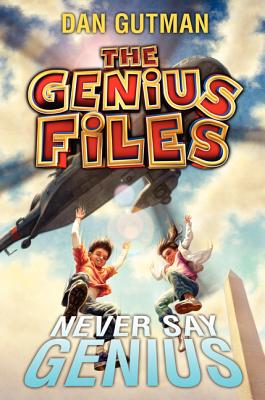 While light on plot, the action is nonstop in Gutman’s sequel. Kids will like that. I liked that. However, I was much more impressed by the information presented in the book, thinly veiled as pertinent to Coke and Pep’s travels. Readers are urged to visit online mapping websites (a la Mapquest or Google Maps) to map each leg of their route from San Francisco to Washington, D.C. Real pictures (often provided by Gutman’s fans!) depict the museums, historic sites, and state signs that the twins encounter. The incorporation of other map features, like highway route signs for page numbers, and the frequent posting of miles left to travel impart a lesson that this GPS-reliant generation may not otherwise get. Add the coded messages that Pep deciphers, and this is one edutaining book!
While light on plot, the action is nonstop in Gutman’s sequel. Kids will like that. I liked that. However, I was much more impressed by the information presented in the book, thinly veiled as pertinent to Coke and Pep’s travels. Readers are urged to visit online mapping websites (a la Mapquest or Google Maps) to map each leg of their route from San Francisco to Washington, D.C. Real pictures (often provided by Gutman’s fans!) depict the museums, historic sites, and state signs that the twins encounter. The incorporation of other map features, like highway route signs for page numbers, and the frequent posting of miles left to travel impart a lesson that this GPS-reliant generation may not otherwise get. Add the coded messages that Pep deciphers, and this is one edutaining book!
Who wouldn’t want to read about Wrigley Field, Cedar Point, the Rock-n-Roll Hall of Fame, and the Smithsonian Museum of American History?!?
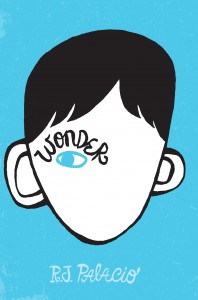 Palacio’s debut novel for middle grade readers should be required reading for children and adults alike. The effects of bullying on the greater school community as well as on the whole family are well-described. I would like to see all third or fourth grade teachers and/or school librarians reading this aloud to their classes. I’d like every administrator in every school to read it and study the administrators’ choices in Wonder. I wish that every adult would read it and accept that ALL people should be treated with respect and a sincere (not “shiny” as Auggie described) smile. Perhaps I have a soft spot in my heart for the victims of bullying, but this is a triumph of a novel.
Palacio’s debut novel for middle grade readers should be required reading for children and adults alike. The effects of bullying on the greater school community as well as on the whole family are well-described. I would like to see all third or fourth grade teachers and/or school librarians reading this aloud to their classes. I’d like every administrator in every school to read it and study the administrators’ choices in Wonder. I wish that every adult would read it and accept that ALL people should be treated with respect and a sincere (not “shiny” as Auggie described) smile. Perhaps I have a soft spot in my heart for the victims of bullying, but this is a triumph of a novel.
